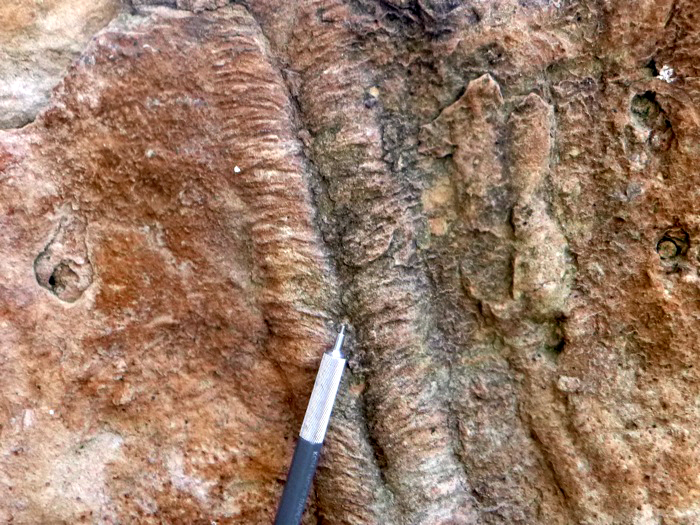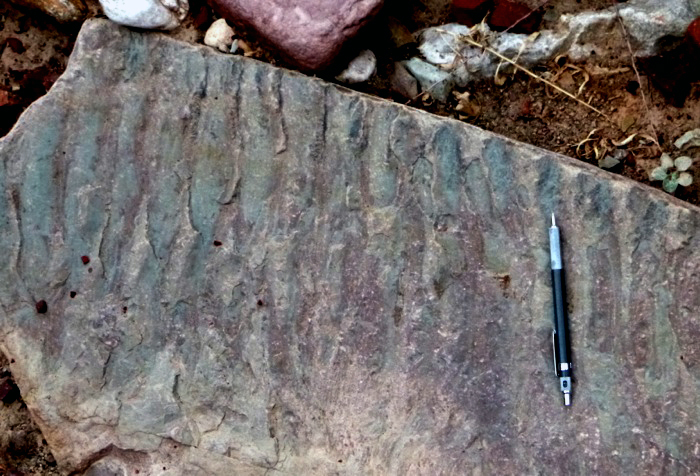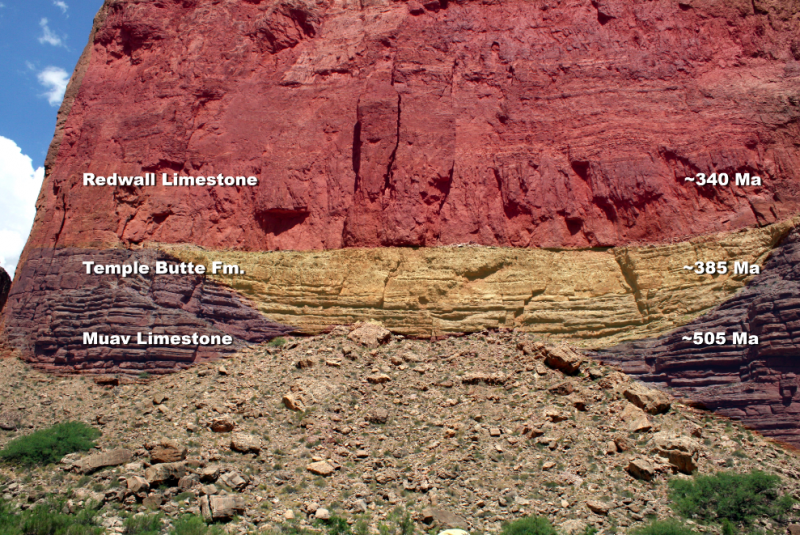Last time we examined what creationists think about how the rocks of Grand Canyon were formed. Now we’re going to look at the fatal flaws in this creationist model, and why it doesn’t fit with what we see in Grand Canyon.
One major flaw is the thickness of the sediment. The flat-lying Paleozoic rocks (the ones which would have formed during the Flood year) vary a lot in thickness depending on the area, but taking averages from the National Park Service, and limiting our calculation to only rocks found in Grand Canyon, we’re talking at least 1165 m from the basal Tapeats Sandstone to the uppermost Kaibab Formation. A detailed timeline published by Answers in Genesis breaks down the day-by-day events of the Flood, and by their estimation the surface of the earth was dry 314 days after the onset of the Flood. To achieve this much sediment in this little time would mean a sustained rate of 3.7 meters (12 feet) of sediment deposition per day, a rate not even remotely observed in the modern world.
Another flaw is the nature of the sediments themselves. In the creationist model, these rocks were laid down in continent-sized roiling slurries of sediment. Steve Austin writes, based on the size of cross-bedding in such sediment, that they formed in “currents of 90 to 155 centimeters per second (three to five feet per second).” That’s about as fast as tsunami deposits move onshore, but Grand Canyon’s Paleozoic rocks don’t look anything like jumbled tsunami deposits.
Here is an example of the trace fossil Cruziana, which records the faint scuttling of a trilobite as it made its way along a sea floor that would become the rocks above Deer Creek Falls. Before hardening as a fossil, such impressions were so ephemeral that the slightest disturbance would destroy them. How could such delicate features possibly be preserved in the deluge of sediment required by the creationist model?

photo: Steven Newton
Ripples and mudcracks also appear throughout the flat-lying Paleozoic rocks in Grand Canyon. How could such dainty features endure an onslaught of raging waters the likes of which not even the most ferocious rapids of the Colorado River could produce?

photo: Steven Newton
Another fatal flaw is the presence of river channels cutting into the sedimentary layers that in the creationist model should have been deep underwater. River channels are cut when gravity inexorably pulls water towards the ocean; once you’ve hit sea level, the erosive power of a river disappears.
Yet in the cliffs of Grand Canyon, we see exposed cross-sections of river channels smack in the middle of rocks supposedly laid down underwater during the Flood. Here is one colorized and labeled example, which rafters encounter at mile 41 on the river:

photo and illustration: Steven Newton
What’s going on here is that the Muav Limestone was deposited in relatively deep water along the coastline of what would become North America. Then over a hundred million years later, the region was uplifted. When rocks are lifted out of the water, they tend to erode rather than deposit; this erosion planed off the top of the Muav (and maybe removed other units as well). Then sinuous rivers cut into the flat top of the Muav, twisting and turning as they undulated toward the sea. We see the remnants of these rivers in the Temple Butte Formation, which is exposed in dramatic half-moon incisions into the Muav. These incisions occur in different orientations as you find them on opposite sides; you’re looking at the cross-section of a twisting fossil river changing its course, much as the Mississippi River does today.
It’s pretty hard to imagine how such river channels could form if they were thousands of feet under water. So how do creationists account for the Temple Butte problem? In Monument to Catastrophe, Steve Austin writes:
Evidently, the Flood waters got shallower and bottom-current velocity increased, allowing soft sediments to be eroded in channels as sedimentation stopped.
Except that at this point, sedimentation was far from stopped, far from the end. We have thousands of feet of rock still to deposit. Above the Muav Limestone and the Temple Butte Formation we’ve still got the Redwall Limestone to drop out of the swirling Flood waters, followed by the whole Supai Group, the Hermit, the Coconino, and so on.
Creationists claim that the most visible layers in Grand Canyon were set down in the waters of Noah’s Flood. But again and again, the creationist position is not supported by the hard, unyielding Grand Canyon rocks. Only by tortuous twistings of logic and special pleading can creationists examine Grand Canyon rocks and maintain that they show evidence of the Flood of Noah.
Next up: Creationist Grand Canyon Claim #3: How Fossils Show “Mass Kills” From Noah’s Flood
